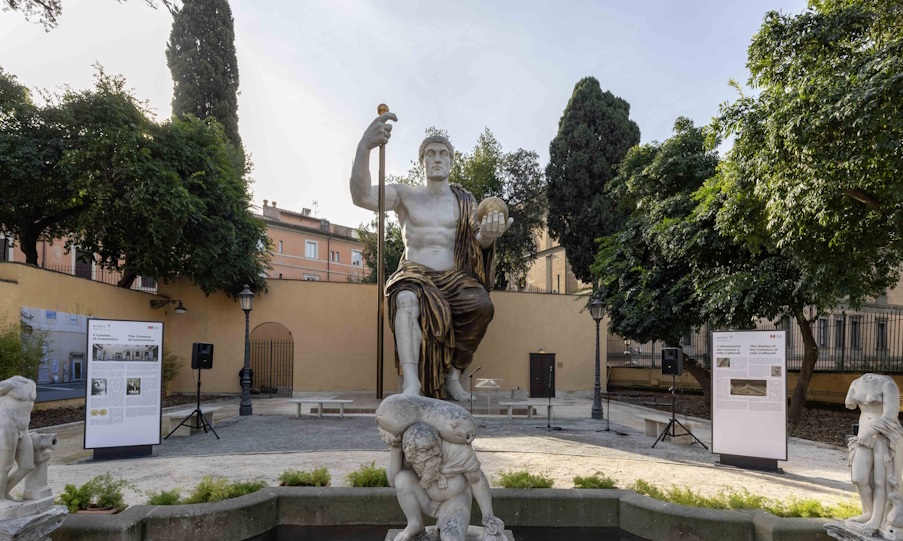
A modern-day reconstruction of the ancient Colossus of Constantine, recreated using 3D modeling technology, was inaugurated on Tuesday at the Capitoline Museums in Rome.
Constantine, also known as Constantine the Great, ruled from 306 to 337 AD and was the first Roman emperor to convert to Christianity and establish Constantinople.
The 13-metre-high statue, on display until 31 December 2025, is a replica of the fourth-century Colossus which once stood in the apse of the Basilica of Maxentius in the Roman Forum.
Rome authorities on Tuesday unveiled a massive, 13-meter replica of the statue Constantine commissioned for himself after 312 AD.
The 4th century ruler embrace of Christianity helped spread the Christian faith throughout the Roman Empire. pic.twitter.com/Tm7oWM97ni
— Citizen Free Press (@CitizenFreePres) February 6, 2024
How the Colossus of Constantine was recreated
The reconstructed statue of the seated emperor, wearing a gilded tunic and holding a scepter and orb, was made after experts digitally scanned the remaining fragments from the original statue – including the head, right arm, right hand, right knee, right shin, a calf fragment, the right and left feet, the wrist and a chest fragment – using the high-resolution data to create 3D models of each piece.
The statue was then reconstructed using resin, polyurethane, and marble powder, gold leaf, and plaster, built around an internal aluminum frame.
The gigantic statue now looms over the gardens at Villa Caffarelli, part of the Capitoline Museums complex, which houses the remaining marble fragments of the original Colossus.
The original Colossus of Constantine, made from marble and gilded bronze, was pillaged and broken before being rediscovered during excavations at the Basilica of Maxentius in the 15th century.
The remaining marble fragments were moved to the courtyard of the Palazzo dei Conservatori in the Capitoline Museums in 1471 as part of the donation by Pope Sixtus IV of ancient Roman pieces to the world’s first public museum.
Constantine the Great returns – a copy of the colossal statue (height 12 metre) is being reconstructed at the Capitoline Museum, Rome.https://t.co/G76kCiPop5 pic.twitter.com/YuG4tIciu7
— Nina Willburger (@DrNWillburger) January 29, 2024
The legacy of Constantine the Great
Constantine was born in 272 in Naissus of Dardania, a city on the Hellespont. In 306, when his father died, he was proclaimed successor to the throne.
In the year 312, upon learning that Maxentius and Maximinus had joined forces against him, he marched into Italy, where, while at the head of his troops, he witnessed the words “By this shalt thou conquer” on a radiant pillar forming a cross in the post-midday sky beneath the sun.
The following night, Jesus Christ appeared to him in a dream and declared to him the power of the Cross and its significance.
When he arose in the morning, he immediately ordered that a labarum be made (which is a banner or standard of victory over the enemy) in the form of a cross, and he inscribed on it the Name of Jesus Christ.
On October 28th, he attacked and conquered Maxentius, who drowned in the Tiber River while fleeing.
The following day, Constantine entered Rome in triumph and was proclaimed Emperor of the West by the Senate while Licinius, his brother-in-law, ruled in the East. However, out of malice, Licinius later persecuted the Christians.
Constantine fought him once and again, and utterly destroyed him in 324. In this manner, he became monarch over the West and East. Under him, and because of him, all the persecutions against the Church ceased. Christianity triumphed and idolatry was overthrown.
In 325, he called the First Ecumenical Council in Nicaea, which he himself personally addressed, to create the Creed that forms the belief system of Christians. In 324, in the ancient city of Byzantium, he laid the foundations of the new capital of his realm and solemnly dedicated it on May 11, 330, naming it after himself, Constantinople.
Since the throne of imperial rule was transferred to Constantinople from Rome, it was named New Rome, and the inhabitants of its domain were called Romans; it was thus considered the continuation of the Roman Empire.
Constantine died between May 21st to May 22nd of the year 337, having lived sixty-five years, of which he ruled for thirty-one. His remains were transferred to Constantinople and were buried in the Church of the Holy Apostles, which he had constructed.
See all the latest news from Greece and the world at Greekreporter.com. Contact our newsroom to report an update or send your story, photos and videos. Follow GR on Google News and subscribe here to our daily email!



